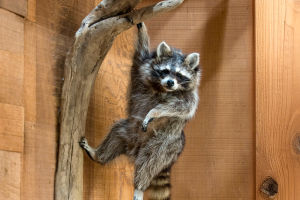
At first glance, a tanuki might look like a raccoon's quirky twin. But looks can be super deceiving—this fuzzy-faced creature is actually a wild dog! Yep, it's part of the canine family, just like wolves, foxes, and domestic dogs.
It's native to Japan and often shows up in legends and folk stories, but there's a lot more to it than just mythology. Let's dive into what makes tanuki so special—and check out 8 facts that'll totally change how you see them.
1. It's not related to raccoons
Even though it's got that masked face and bushy tail, the tanuki is not a raccoon at all. Raccoons belong to a completely different animal group that's closer to weasels, otters, and badgers. Tanuki are canines—so if anything, they're more like shaggy forest dogs. This lookalike situation is just nature's trick called “convergent evolution,” where unrelated animals evolve to look alike because they live in similar environments.
2. It's one of the few dogs that can climb trees
Tanuki are surprisingly good at climbing! That's pretty rare for dogs, but tanuki have curved claws that help them scale trees just like cats. They share this tree-climbing talent with the gray fox of North America. They often climb up to reach fruit and berries, and if needed, they can even swim or dive underwater to hunt. Talk about a multi-talented little critter.
3. It's been targeted by the fur trade
Sadly, tanuki have been heavily exploited in the fur industry. Along with their mainland cousins, raccoon dogs, they've been farmed for their thick fur, which is sometimes falsely labeled as fake fur. Shocking, right? The Humane Society even found that many “faux fur” products in stores actually contain real tanuki fur. These animals spend their whole lives in cages, making them a heartbreaking symbol of the darker side of the fashion world.
4. It's an invasive species in Europe
Civet cats were introduced for fur farming in the early 20th century. From there, they spread across Europe and are now considered an invasive species in many countries. With few natural predators and a knack for scavenging near human towns, their numbers exploded fast. Some European governments are now trying to control their population to protect native wildlife—and discourage people from keeping them as exotic pets.
5. It's super social
Tanuki aren't lone wolves—they're all about family life. They usually live in monogamous pairs or small family groups and even raise their pups together. The dad helps out a lot—bringing food to the mom and looking after the babies. That close-knit teamwork means the pups stay with their parents for months, getting all the love and care they need to thrive.
6. It's the only dog that hibernates
When winter hits, tanuki take a totally different route from most of their canine cousins. Instead of braving the cold, they bulk up in the fall and then go into a semi-hibernation state. Their metabolism slows down by up to 50%, and they snuggle into dens to ride out the cold. They're not in a deep sleep the whole time—on warmer days, they might pop out for a quick snack—but it's still pretty rare behavior for a dog.
7. It's a legendary figure in Japanese folklore
In Japan, the tanuki is more than just a real animal—it's also a mythical trickster. These magical tanuki first appeared in Japanese records way back in 720 AD, and over time they became famous for shapeshifting and playing pranks. In folklore, they're believed to bring good luck and are often shown with exaggerated features, especially their oversized... uh, pouches, which once symbolized luck and wealth for metalworkers.
8. It's one of the oldest wild dog species
Tanuki are considered a "primitive" species—meaning they've stayed pretty close to their ancient ancestors. Fossils found in Japan's Tochigi Prefecture show that tanuki have been around since the Pleistocene era, which was between 2.5 million and 11,700 years ago. They have a wide-ranging diet, make unusual sounds like howls and cat-like meows, and give us a cool peek into how wild dogs evolved.
So, what makes tanuki so fascinating?
They're not just cute fluffballs from folk tales—they're smart, social, and seriously unique. Whether they're climbing trees, dozing through winter, or showing up in myths with magical powers, tanuki keep surprising us. What fact amazed you the most, Lykkers? Have you ever seen one before—or maybe a statue of one in a Japanese garden?
Let's keep learning together. There's always something wild and wonderful to discover out there!


